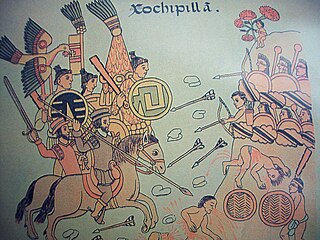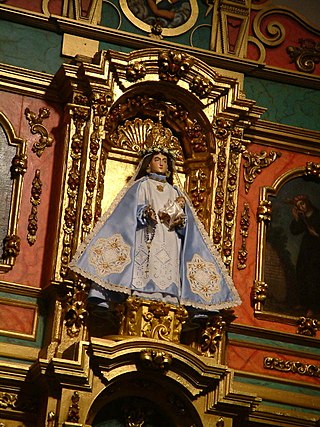Conquistador is a term used for explorers and conquerors from Iberia during the Age of Discovery.
Contents
Conquistador or variation, may also refer to:
Conquistador is a term used for explorers and conquerors from Iberia during the Age of Discovery.
Conquistador or variation, may also refer to:

Pedro de Alvarado was a Spanish conquistador and governor of Guatemala. He participated in the conquest of Cuba, in Juan de Grijalva's exploration of the coasts of the Yucatán Peninsula and the Gulf of Mexico, and in the conquest of the Aztec Empire led by Hernán Cortés. He is considered the conquistador of much of Central America, including Guatemala, Honduras and El Salvador.
Hollywood usually refers to:

Juan de Oñate y Salazar was a Spaniard conquistador from New Spain, explorer, and colonial governor of the province of Santa Fe de Nuevo México in the viceroyalty of New Spain. He led early Spanish expeditions to the Great Plains and Lower Colorado River Valley, encountering numerous indigenous tribes in their homelands there. Oñate founded settlements in the province, now in the Southwestern United States.

Walter Maynard Ferguson CM was a Canadian jazz trumpeter and bandleader. He came to prominence in Stan Kenton's orchestra before forming his own big band in 1957. He was noted for his bands, which often served as stepping stones for up-and-coming talent, his versatility on several instruments, and his ability to play in a high register.

Bad Company are an English rock supergroup that was formed in 1973 by singer Paul Rodgers, guitarist Mick Ralphs, drummer Simon Kirke and bassist Boz Burrell. Peter Grant, who managed the rock band Led Zeppelin, also managed Bad Company until 1982.
Angels are a type of creature present in many mythologies.
The Beast may refer to:

Inca Garcilaso de la Vega, born Gómez Suárez de Figueroa and known as El Inca, was a chronicler and writer born in the Viceroyalty of Peru. Sailing to Spain at 21, he was educated informally there, where he lived and worked the rest of his life. The natural son of a Spanish conquistador and an Inca noblewoman born in the early years of the conquest, he is known primarily for his chronicles of Inca history, culture, and society. His work was widely read in Europe, influential and well received. It was the first literature by an author born in the Americas to enter the western canon.

Robin Leonard Trower is an English rock guitarist who achieved success with Procol Harum throughout 1967–1971, and then again as the bandleader of his own power trio known as the Robin Trower Band.
Adelantado was a title held by some Spanish nobles in service of their respective kings during the Middle Ages. It was later used as a military title held by some Spanish conquistadores of the 15th, 16th and 17th centuries.
The Edmonton Symphony Orchestra (ESO) is a Canadian orchestra based in Edmonton, Alberta. As the professional orchestra of Alberta's creative capital city it presents over 85 concerts a year of symphonic music in all genres, from classical to country. Currently in its 72nd season, the orchestra is composed of 56 core professional musicians who perform 42 weeks per season and who play an active role in the musical life of Edmonton and elsewhere as performers, teachers and recording artists. The ESO also performs as the orchestra for Edmonton Opera and Alberta Ballet productions, and its recordings are regularly heard across Canada on CBC Radio 2.
Conquest is the act of military subjugation of an enemy by force of arms.
A conqueror is a person who conquers.

Ian Russell Wallace was an English rock and jazz drummer, most visibly as a member of progressive rock band King Crimson, as a member of David Lindley's El Rayo-X and as Don Henley's drummer.
A kaleidoscope is a tube of mirrors containing small colored objects.

The Mixtón War (1540-1542) was a rebellion by the Caxcan people of northwestern Mexico against the Spanish conquerors. The war was named after Mixtón, a hill in Zacatecas which served as an Indigenous stronghold.

The Castillo de la Real Fuerza is a bastion fort on the western side of the harbour in Havana, Cuba, set back from the entrance, and bordering the Plaza de Armas. Originally built to defend against attack by pirates, it suffered from a poor location; it was too far inside the bay. The fort is considered to be the oldest stone fort in the Americas, and was listed in 1982 as part of the UNESCO World Heritage Site of "Old Havana and its Fortifications".

Isabel de Bobadilla, or Inés de Bobadilla was the first female governor of Cuba from 1539–1543.

The Acoma Massacre refers to the punitive expedition by Spanish conquistadors at the Acoma Pueblo in January, 1599 that resulted in the deaths of around 500 Acoma men and 300 women and children after a three-day battle. Of the Acoma who survived the attack, many were sentenced to 20-year terms of bondage, and 24 suffered amputations.

La Conquistadora is a small wooden statue of the Madonna and Child now in the Cathedral Basilica of St. Francis of Assisi in Santa Fe, New Mexico. She was the first Madonna brought to what is now the United States. The statuette is carved out of wood, and measures approximately three feet in height. A Catholic confraternity called, La Cofradía de La Conquistadora, exists to “promote devotion to the Mother of God under the title of La Conquistadora – Our Lady of Peace, and for the upkeep and maintenance of both of her chapels at the Cathedral Basilica of St. Francis of Assisi and the Rosario Chapel”. This confraternity is also responsible for maintaining the icon's chapel located in the north transept of the Basilica. The icon is dressed by the sacristana, or sacristan who maintains the vast wardrobe that includes clothing, veils, crowns, jewels and wigs. Cancer survivors often donate hair for use in fashioning wigs worn by the statue. The garments that the icon is clothed in are often sewn and donated by the faithful; all are rich in detail and very fine, often with elaborate designs. The estimate of her total outfits is close to 300. Even non-Catholics find occasion to honor the statue. For example, actress Ali MacGraw commissioned a piece that was displayed at Santa Fe's Spanish Colonial Museum in an exhibit about the icon mounted during 2010. The statue's origins are not well-known, but the 15th and 17th centuries are the most likely possibilities. Her arrival into America was made possible by the Spanish, who carried several versions of The Virgin Mary with them on their travels. There is a long history of armies carrying statues of saints into battle, for various purposes. Although the exact date of the statue's arrival in the New World is unknown, the Madonna was brought to New Mexico via Mexico City by priest Fray Alonso de Benavides, arriving in Santa Fe on January 25, 1626. Benavides wrote about this date in his journal, but the Archdiocese commonly uses the date of 1625. La Conquistadora was originally known as Our Lady of the Assumption.